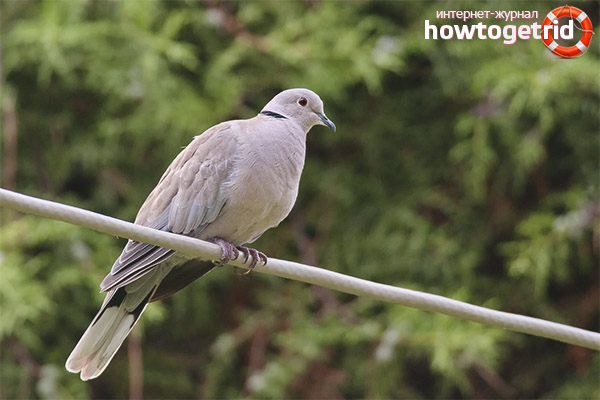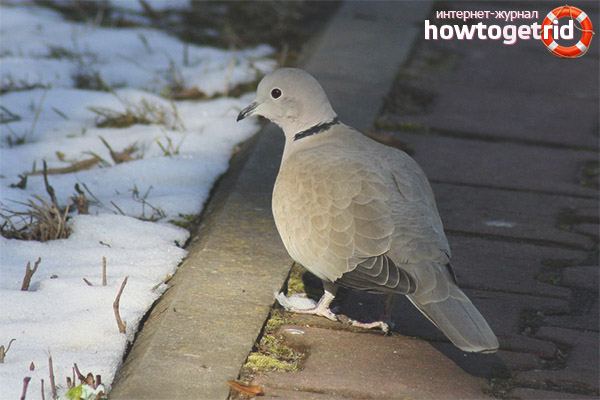The content of the article
The ringed dove is ranked as a pigeon-like order, belongs to the pigeon family. The body length of this bird reaches 33 centimeters, and the width of its wingspan reaches 55 centimeters. The maximum body weight of an adult is 210 grams.
Plumage painted in a bluish-brown hue is located on the back of the dove and in the upper part of the wings, and in the lower part of its body the plumage is painted in pinkish-bluish tones. A distinctive feature of this bird is the white plumage of the tip of the tail and the black half ring located on its neck. On the fly, this representative of the pigeon family clearly shows a white plumage that colors the lower part of the tail, and the wing feathers of the wings are presented in black.
The manner of flight of the ringed neck is distinguished by its lightness and speed. While on the ground, birds prefer to spend time in continuous communication, consisting of repeated monotonous sounds, returning to the nest, they report their approach with a short piercing scream. Today, Streptopelia can be called urban dwellers, who safely accept the neighborhood with people. They can easily be found in city parks or squares, on boulevards and squares. It is hard to imagine that it is a forest bird in its origin.
Streptopelia habitats
In the recent past, ringed turtledoves can be found in forests located in the northern part of Africa, as well as Asia Minor; it also lived in the southern regions of the Asian continent. With the advent of the 20th century, these discreet pigeons became widespread, it is noteworthy that in the new territories they were not attracted at all by forests, but by the proximity to places of active human activity. In winter, they prefer to stay in large flocks, choosing places where it is easy to get hold of grain.
For this purpose, any farm, nursery, menagerie, the territory of a granary, a grain processing complex or a poultry farm is suitable for birds. Representatives of this species, who have chosen the central part of Europe as their new habitat, coexist perfectly in any settlements, in the immediate vicinity of humans.
Diet and method of feeding gray pigeon
Various cereal crops or seeds of agricultural plants serve as fodder for Streptopelia, they also do not refuse seeds of wild cereals and herbs. Young green shoots of many plants, their buds and inflorescences, even berries and some fruits, are also suitable for forage. In addition, they willingly eat the larvae of many insects, land varieties of snails and earthworms, which are especially actively collected in the offspring breeding season.
The feed that the turtledove swallows initially enters the so-called goiter, it consists of two processes of the esophagus tube, it serves as a preliminary link in the digestive system of the bird. Having thoroughly stuffed its goiter, the bird is removed to a safe place for unhurried assimilation of the received portion. It is noteworthy that for more efficient processing of grain in the stomach of a bird, pigeons have to swallow small stones.
Offspring
Ringed Streptopelia inhabiting Europe have a long nesting period, it begins with the advent of March and can last until the end of October. Some individuals are able to produce offspring even in winter. With a good combination of circumstances, when there is enough safe area for nesting and there is no shortage of food, doves living in the eastern part of Europe are able to reproduce their offspring all year round, in the manner of poultry.
In the mating season, males use peculiar flight figures to attract females. Taking off into the air, almost at a vertical angle, “air acrobats” descend along a certain path, outlining an imaginary spiral in the sky, each turn of which is larger than the previous one. This performance is accompanied by a melodic song called pigeon coo.
Having landed on the ground, inspired cavaliers transgress to the second part of the ceremonial performance. Having come closer to his chosen one, the male begins energetic turns, bowing down gallant bows and showing in all its glory his loose plumage. Having reached an agreement, the birds begin the obligatory ceremony, they carefully clean the plumage of each other, this ceremony is so important for them that they can continue these actions for several hours without a break.
Both individuals take part in the nest device. It is noteworthy that the extraction of all kinds of twigs and stems of dry grass, used as the main building material, deals exclusively with the male. But the female acts as the “architect” himself, she does not trust him with such a responsible mission. The nest of the turtledove has a mundane cup-like shape.
As a rule, two small eggs of white color are found in the stonework of the dove. Both parents take part in hatching offspring, at night the female takes up duty, and during the day the male takes on these duties. The incubation period of these birds lasts about 15 days, and, always, the first chick appears a couple of days earlier than the second. Ringed doves contain their chicks on a special diet, this type of feed was called "bird milk", it consists of a partially digested portion of the parents, densely supplied with secretion of glands located in the goiter of the bird.
Young doves become winged very quickly, they get their first flight experience at two weeks of age. If the conditions are favorable, then a pair of these pigeons can grow 4 broods per year.
Interesting Facts
The migratory pigeon, which was in a distant relationship with the turtledove, represented one of the most common bird populations living on the North American continent in the late 19th century. Colonies of these birds located their nests on an area of 2,200 kilometers within the territory of the state of Wisconsin, and about 136 million animals were collected here every year. In the end, wild birds were completely exterminated by man.
The so-called pigeon "bird's milk" is used in these birds not only for feeding chicks. During courtship, the male presents a similar delicacy to his beloved. The special composition of this drug acts as a catalyst for female libido.
Video: ringed dove (Streptopelia decaocto)











Submit